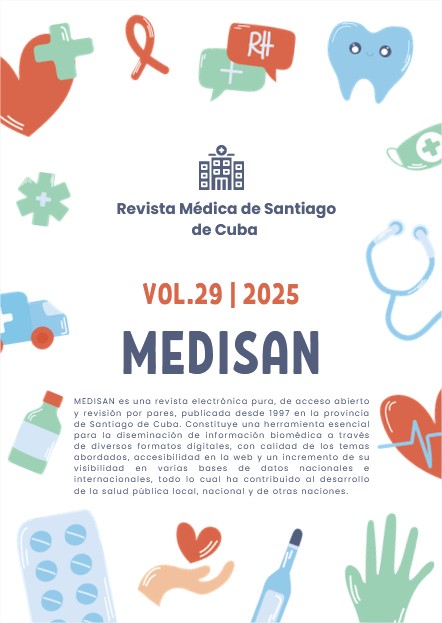Moxibustion in postpartum women with hypogalacthy
Keywords:
medicina natural tradicional, puérperas, hipogalactia, lactancia materna, moxibustionAbstract
Introduction: the Moxibustion is a method of the traditional natural medicine that consists on introducing heat into the body through the action of burning tobacco or moxa stick.Objective: To evaluate the results of moxibustion treatment in postpartum women with hypogalacthy at Dr. Juan Bruno Zayas Hospital in 2023.Methods: A quasi-experimental study was carried out to evaluate the results of moxibustion treatment in postpartum women with hypogalacthy at the Dr. Juan Bruno Zayas Hospital in Santiago de Cuba. 100 admitted postpartum women were selected, including 50 of them that reported limited milk secretion. For their realization you carries out before a survey and after proceeding. The Data were collected using data sheets that analyze the variables age, turgidity mammary, reasons for discontinuing breastfeeding before the treatment, and the postpartum woman's satisfaction after the procedure.Results: After having applied the moxibustion, turgidity mammary immediate was obtained. Psychological problems were the reason for discontinuing breastfeeding before moxibustion treatment, and the postpartum woman's level of satisfaction was noted after the procedure. The results were then evaluated as a percentage and expressed in tables.Conclusions: The results of moxibustion treatment in postpartum women with hypogalacthy were evaluated, achieving immediate breast turgidity, rapid milk let-down and, consequently, adequate psychological acceptance in them, which allowed for effective breastfeeding.
Downloads
References
1.Organización Mundial de la Salud. Ginebra, Suiza: OMS; c2022[ citado 12/02/2024]. Global breastfeeding scorecard 2022: protecting breastfeeding through further investments and policy actions. Disponible en: http://apps.who.int/iris/bitstream/handle/10665/365140/WHO-HEP-NFS-22.6-eng.pdf?sequence=1&isAllowed=y
2.Flores Estrella MD, Centeno Villavicencio ML, Maldonado Rivadeneira JC, Robles Rodríguez J, Castro Burbano J. Lactancia materna exclusiva y factores maternos relacionados con su interrupción temprana en una comunidad rural de Ecuador. Acta Pediatr Méx. 2021[citado 19/07/2024];42(2):56-65. Disponible en: https://www.medigraphic.com/pdfs/actpedmex/apm-2021/apm212b.pdf
3. Meek JY, Noble L, Section on Breastfeeding. Policy Statement: Breastfeeding and the Use of Human Milk. Pediatrics. 2022[citado19/07/2024];150 (1): e2022057988.
Disponible en: https://renaissance.stonybrookmedicine.edu/system/files/peds_2022057988.pdf
4.Organización Mundial de la Salud. Ginebra, Suiza: OMS; c2020 [actualizado 28/08/2023; [citado20/01/2025]. Cumbre Mundial de la OMS sobre Medicina Tradicional destaca evidencias científicas e integración a los sistemas de salud; [aprox. 5 p.]. Disponible en: https://www.paho.org/es/noticias/28-8-2023-cumbre-mundial-oms-sobre-medicina-tradicional-destaca-evidencias-cientificas
5.Pérez Escamilla R, Buccini GS, Segura Pérez S, Piwoz E. Perspective: Should Exclusive Breastfeeding Still Be Recom-mended for 6 Months? Adv Nutr. 2019[citado 25/12/2024];10(6):931-943. Disponible en: https://pmc.ncbi.nlm.nih.gov/articles/PMC6855974/
6.López Puig P, García Milián AJ, Perdomo Delgado J, Segredo Pérez A. Integración de la medicina natural y tradicional cubana en el sistema de salud. Rev. cuba. salud pública. 2019[citado 25/12/2024];45(2):e1168. Disponible en: https://www.scielosp.org/pdf/rcsp/2019.v45n2/e1168/es
7.González Castell LD, Unar Munguía M, Quezada Sánchez AD, Bonvecchio Arenas A, Rivera Dommarco J. Situación de las prácticasde lactancia materna y alimentación complementaria en México: resultados de la Ensanut 2018-19. Salud Pub Mex. 2020 [citado 17/05/2023];62(6): 704-13. Disponible en: https://www.saludpublica.mx/index.php/spm/article/view/11567/11972
8.Zakarija-Grkovic I, Stewart F. Treatments for breast engorgement during lactation. Cochrane Database Syst Rev. 2020 [citado 18/12/2024].82 p. Disponible en: https://pmc.ncbi.nlm.nih.gov/articles/PMC8094412/pdf/CD006946.pdf
9.Sanches Valdeolla O. Particularidades de empleo de la medicina natural y tradicional en los cinco continentes. Rev. Cuban. de med. nat. trad. 2020[citado 18/07/2024];3(1):e107. Disponible en: https://revmnt.sld.cu/index.php/rmnt/article/view/107/98
10.Matos Guilarte C, Gómez Pérez Y, Martínez Valencia N, Garrido Quintero D, Arguelles Rodríguez JC. Enfoque terapéutico desde la Medicina Natural y Tradicional para la hipogalactia materna. Rev. inf. cient. 2018 [citado 01/09/2024];97(2):270-80. Disponible en: https://revinfcientifica.sld.cu/index.php/ric/article/view/1846/3597
11.Tácuna Calderón A., Moncada Mapelli E., & Lens Sardón L. Estrategias de la Organización Mundial de la Salud en Medicina Tradicional. Rev. cuerpo méd. HNAAA. 2020[citado 01/09/2024];13(1):101-2. Disponible en: http://www.scielo.org.pe/pdf/rcmhnaaa/v13n1/2227-4731-rcmhnaaa-13-01-101.pdf
12.Perdomo Delgado J, González Pla EA, Carrero Figueroa M, Beltrán Delgado M, Avello Romero L. Principales resultados del Programa de Medicina Natural y Tradicional en Cuba (2018-2019). Rev. cuban. med. nat. trad. 2020[citado 01/09/2024];3(1):e163. Disponible en: https://revmnt.sld.cu/index.php/rmnt/article/view/163/107
13.Hoyt Austin AE, Kair LR, Larson IA, Stehel EK. Academy of Breastfeeding Medicine. Academy of Breastfeeding Medicine Clinical Protocol #2: Guidelines for Birth Hospitalization Discharge of Breastfeeding Dyads, Revised 2022. Breastfeed Med 2022[citado 21/10/2024];17(3):197-206. Disponible en: https://pmc.ncbi.nlm.nih.gov/articles/PMC9206473/
14.Segura Pérez S, Richter L, Rhodes EC, Hromi Fiedler A, Vilar Compte M, Adnew M, et al. Risk factors for self-reported insufficient milk during the first 6 months of life: A systematic review. Matern Child Nutr. 2022[citado 14/10/2023];18(Suppl3):e13353. Disponible en: https://pmc.ncbi.nlm.nih.gov/articles/PMC9113468/
15.Campiño Valderrama SM, Duque PA. Lactancia materna: factores que propician su abandono. Archivos de Medicina (Col). 2019[citado 24/07/2023];19(2):331-44. Disponible en: https://www.redalyc.org/jatsRepo/2738/273860963013/273860963013.pdf
16.Tapia Sequeiros G, Velazco Cañari MA, Ramos Calizaya N, Medina Vicente LA, Rodriguez Flores C, Ventura Ramírez F, et al. Factores asociados con la interrupción de la lactancia materna exclusiva: análisis transversal de una encuesta nacional peruana. Acta Pediatr Méx. 2023[citado 27/09/2024];44(4):263-275. Disponible en: https://ojs.actapediatrica.org.mx/index.php/APM/article/view/2687
17.Neville MC. Lactation in the human. Anim Front. 2023[citado 27/09/2024];13(3):64-70. Disponible en: https://pmc.ncbi.nlm.nih.gov/articles/PMC10266744/pdf/vfad021.pdf
18.González Castell LD, Unar Munguía M, Bonvecchio Arenas A, Ramírez Silva I, Lozada Tequeanes AL. Prácticas de lactancia materna y alimentación complementaria en menores de dos años de edad en México. Salud Pub Mex. 2023[citado 11/01/2025];65 (Supl1):S204-S210. Disponible en: https://ensanut.insp.mx/encuestas/ensanutcontinua2022/doctos/analiticos/26-Lactancia.materna-ENSANUT2022-14805-72471-2-10-20230619.pdf
19.Hernández Cordero S, Lozada Tequeanes AL, Fernández Gaxiola AC, Sachse M, Shamah Levy T, Veliz P, et al. Barriers and facilitators to breastfeeding during the immediate and one month postpartum periods, among Mexican women: a mixed methods approach. Int Breastfeed J. 2020[citado 17/09/2024];15:87. Disponible en: https://internationalbreastfeedingjournal.biomedcentral.com/counter/pdf/10.1186/s13006-020-00327-3.pdf
20.Ricardo Rigol O, Santiesteban Alba SR. Obstetricia y Ginecología. 4ª. ed. La Habana: Editorial Ciencias Médicas; 2023. [citado 17/05/2024].610 p. Disponible en: http://www.bvscuba.sld.cu/libro/obstetricia-y-ginecologia-cuarta-edicion/
Downloads
Published
How to Cite
Issue
Section
License
Copyright (c) 2025 MEDISAN

This work is licensed under a Creative Commons Attribution 4.0 International License.
All the articles can be downloaded or read for free. The journal does not charge any amount of money to the authors for the reception, edition or the publication of the articles, making the whole process completely free. Medisan has no embargo period and it is published under the license of Creative Commons, International Non Commercial Recognition 4.0, which authorizes the copy, reproduction and the total or partial distribution of the articles in any format or platform, with the conditions of citing the source of information and not to be used for profitable purposes.





